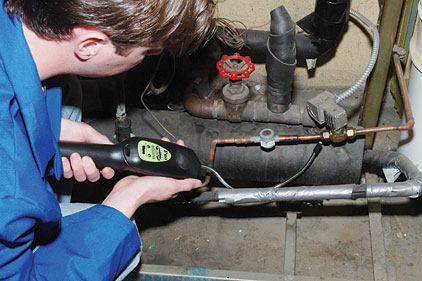
HomeAdvice products identify problems having to do with temperature, humidity, carbon monoxide (CO), carbon dioxide (CO2), particulates (dust), and volatile organic compounds (chemicals and odors).
Indoor air quality is something that can’t be seen or heard - but it can be measured. And the better the method of measurement, the better the chances of reducing contaminant, allergen, and dust levels in the environment.
Ian Cull, technical director for the Indoor Air Quality Association (IAQA), said, “HVAC contractors should recommend that building owners monitor their humidity and ventilation levels. If these are already measured by a building automation system in a large building, it would still be worthwhile to spot check the facility with handheld instruments. Carbon dioxide levels in fully occupied areas can indicate if the ventilation is inadequate.”
• Test instruments have reached new levels of sophistication. Here are some examples:
• Hand-held particle counters register down to 0.3 micrograms while measuring several other parameters.
• Hand-held sensors measure pollution levels in time increments, allowing the user to determine a baseline for each parameter, identify the size and timing of any spikes, and better understand pollution sources.
• Plug-and-play monitors that use an outlet for power and phone line for communication. The monitor collects and time stamps measurements and uploads that data, which is analyzed - identifying accepted norms and pointing out anomalies, with suggested corrective actions.
Yet, in spite of the sophistication of test instruments, one of the hardest contaminants to detect is mold or mold spores, according to Don Aultman, vice president and general manager of the residential division of AirAdvice. “Mold is the most challenging,” he said. “Visual inspection can uncover mold that is out in the open, but mold can also occur in difficult to reach locations, such as in ductwork, behind wallpaper, etc. Detection by sensors also is difficult, and subject to interpretation of sensor data. There are no mold sensors per se. Instead, analysis of a combination of particulate and humidity sensor data can indicate the potential for mold. A positive result indicates the need for further study.”
Cull takes a no-nonsense approach to an age-old way to detect contaminants. “The most important piece of equipment is your brain, which collects information from your senses,” he said. “A basic assessment should also include equipment to measure temperature, humidity, ventilation, pressurization and moisture. When these tools are used correctly, the cause of most indoor air quality problems can be discovered. More advanced assessments may require specialized equipment and samples for laboratory analysis.”
HVAC contractors looking into adding IAQ services to their market mix have a lot of education at their fingertips, too. “We use the Indoor Air Quality Association (IAQA) program to qualify our technicians for the Certified Indoor Environmentalist (CIE) certificate,” said Aultman.
According to Robert P. Scaringe, P.E., Ph.D., president of Mainstream Engineering in his report, The Relationship Between Ductwork and IAQ, “Becoming an IAQ service contractor is a natural extension of a/c service practices because it employs many of the same principles contractors already use. Many manufacturers offer IAQ training courses. A free IAQ training manual is available at www.epatest.com/IAQ/manual/manual.jsp and free online training software is downloadable from www.epatest.com/software.”
“We recommend that when the HVAC contractor schedules routine HVAC system maintenance calls they should screen customers for potential IAQ issues and determine whether or not an IAQ test is appropriate,” said Aultman.
“Appropriate screening questions include the following:
• Do any household members suffer from asthma or allergies (potential pollen, dust or mold contamination)?
• Do any household members suffer from persistent headaches (potential CO, VOC or mold contamination)?
• Does the house have persistent odor (potential VOC contamination)?
• Is the house “stuffy” (potential high CO2 levels)?”
“Contractors can also work with building owners to make sure that the filtration is appropriate for the needs of the building and the capacity of the HVAC system,” Cull said. “Recommend that everyone be on the lookout for indicators of IAQ problems. This includes water staining, odors, condensation, and an increase of complaints from occupants.”
AN AIR SOLUTION
Aultman said his company offers a HomeAdvice™ portable diagnostic system, which “provides easy, automated assessments of home air quality and energy efficiency.” The platform identifies problems having to do with temperature, humidity, carbon monoxide (CO), carbon dioxide (CO2), particulates (dust), and volatile organic compounds (chemicals and odors).“The technology includes the monitor, software, and reports,” Aultman said. “The Model 5100 IAQ Monitor is a full-featured device for measuring dust/particles, chemical pollutants, carbon dioxide, carbon monoxide, temperature, and relative humidity. The monitor contains a modem to send data to the HomeAdvice servers over a phone line. When not connected, the monitor can store data for up to 14 days. Optionally, it can be deployed with other satellite monitors to provide a room-by-room picture of the home’s IAQ and comfort.”
Aultman added that the software is web-based and available from any Internet-connected computer and the reports are action-oriented, showing red/yellow/green on each of the measured variables. Yellow and red measurements are paired with recommendations.
“Basically, the system involves a two-step process,” he said. “The homeowner places a monitor in their home. Data is automatically transmitted to our data center through the cellular network or a phone line. Then they log onto our website to see the IAQ and energy efficiency issues and corrective recommendations.”
Publication date:07/18/2011


Report Abusive Comment